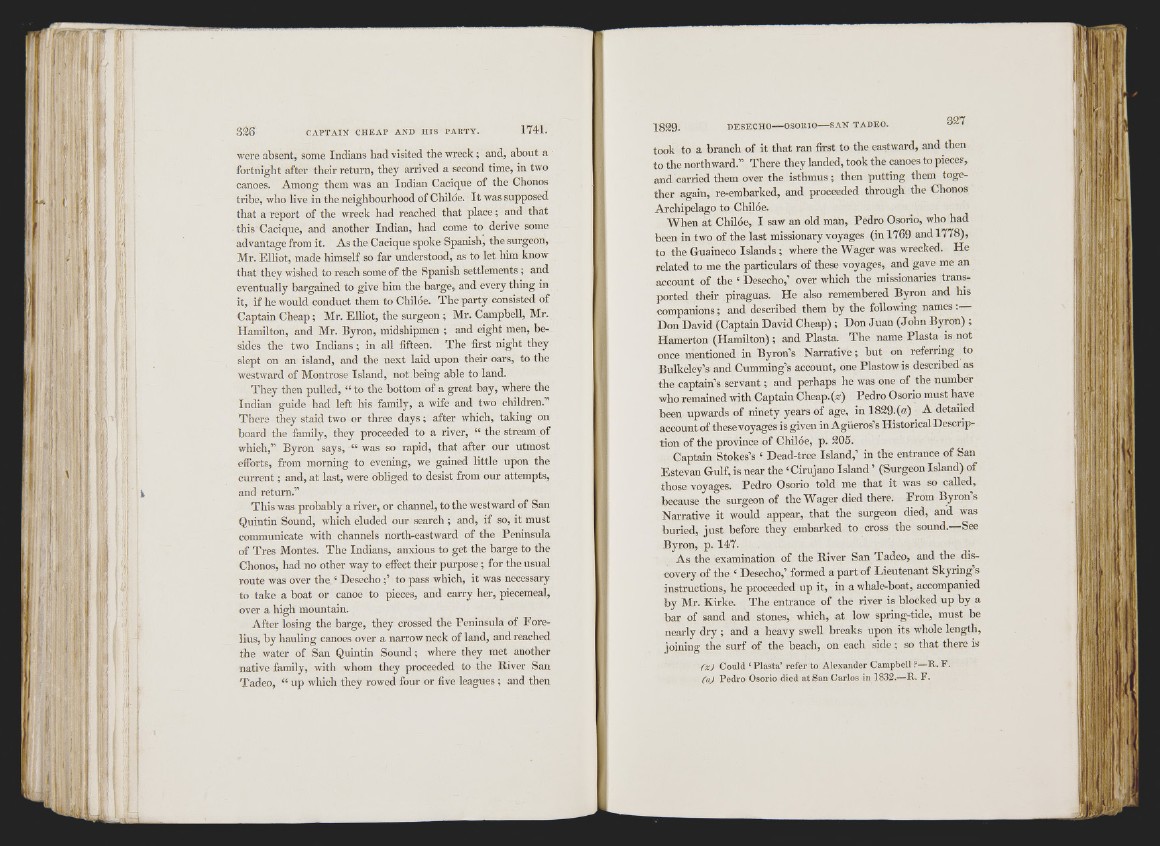
were absent, some Indians had visited the wreck; and, about a
fortnight after their return, they arrived a second time, in two
canoes. Among them was an Indian Cacique of the Chonos
tribe, who live in the neighbourhood of Chiloe. It was supposed
that a report of the wreck had reached that jilace; and that
this Cacique, and another Indian, had come to derive some
advantage from it. As the Cacique spoke Spanish, the surgeon,
Mr. Elliot, made himself so far understood, as to let him know
that they wished to reach some of the Spanish settlements ; and
eventually bargained to give him the barge, and every thing in
it, if he would conduct them to Chilóe. The party consisted of
Captain Cheap; Mr. Elliot, the surgeon ; Mr. Campbell, Mr.
Hamilton, and Mr. Byron, midshipmen ; and eight men, besides
the two Indians; in all fifteen. The first night they
slept on an island, and the next laid upon their oars, to the
westward of Montrose Island, not being able to land.
They then pulled, “ to the bottom of a great bay, where the
Indian guide had left his family, a wife and two children."
There they staid two or three days; after which, taking on
boai’d the family, they proceeded to a river, “ the stream of
which," Byron says, “ was so rapid, that after our utmost
efforts, from morning to evening, we gained little upon the
current; and, at last, were obliged to desist from our attempts,
and return.”
This was probably a river, or channel, to the westward of San
Quintin Sound, which eluded our search; and, if so, it must
communicate with channels north-eastward of the Peninsula
of Tres Montes. The Indians, anxious to get the barge to the
Chonos, had no other way to effect their purpose; for the usual
route was over the ‘ Desecho ;’ to pass which, it was necessary
to take a boat or canoe to pieces, and carry her, piecemeal,
over a high mountain.
After losing the barge, they crossed the Peninsula of Fore-
lius, by hauling canoes over a narrow neck of land, and reached
the water of San Quintin Sound; where they met another
native family, with whom they proceeded to the liiver San
Tadeo, “ up which they rowed four or five leagues ; and then
took to a branch of it that ran first to the eastward, and then
to the northward." There they landed, took the canoes to pieces,
and carried them over the isthmus; then putting them together
again, re-embarked, and proceeded through the Chonos
Archipelago to Chilóe.
When at Chilóe, I saw an old man, Pedro Osorio, who had
been in two of the last missionary voyages (in 1769 and 1778),
to the Guaineco Islands ; where the Wager was wrecked. He
related to me the particulars of these voyages, and gave me an
account of the ‘ Desecho,’ over which the missionaries transported
their piraguas. He also remembered Byron and. his
companions; and described them by the following names :—
Don David (Captain David Cheap) ; Don Juan (John Byron) ;
Hamerton (Hamilton) ; and Plasta. The name Plasta is not
once mentioned in Byron’s Narrative; but on referring to
Bulkeley’s and Cumming’s account, one Plastow is described as
the captain’s servant; and perhaps he was one of the number
who remained with Captain Cheap.(s;) Pedro Osorio must have
been upwards of ninety years of age, in 1829.(«) _ A detailed
account of these voyages is given in Agueros’s Historical Description
of the province of Chilóe, p. 205.
Captain Stokes’s ‘ Dead-tree Island,’ in the entrance of San
Estevan Gulf, is near the ‘Cirujano Island ’ (Surgeon Island) of
those voyages. Pedro Osorio told me that it was so called,
because the surgeon of the Wager died there. From Byron’s
Narrative it would appear, that the surgeon died, an'd was
buried, just before they embarked to cross the sound.— See
Byron, p. 147.
As the examination of the River San Tadeo, and the discovery
of the ‘ Desecho,’ formed a part of Lieutenant Skyring's
instructions, he proceeded up it, in a whale-boat, accompanied
by Mr. Kirke. The entrance of the river is blocked up hy a
bar of sand and stones, which, at low spring-tide, must be
nearly dry ; and a heavy swell breaks upon its whole length,
joining the surf o f the beach, on each side; so that there is
('zj Could ‘ Plasta’ re fe r to Alexander Campbell ?—R . F .
fiij Pedro Osorio died a t San Carlos in 1832.—R. F .
T .I’I